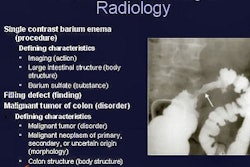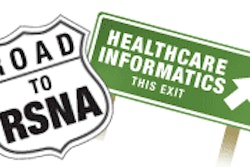ORLANDO, FL - The use of speech recognition applications to generate diagnostic radiology reports leads to shorter reports when compared with analog dictation methods, according to a presentation Friday afternoon at the Society for Computer Applications in Radiology (SCAR) annual meeting.
Dr. Kavin Mistry and colleagues from the department of radiology at Thomas Jefferson University Medical College in Philadelphia presented the results of a study that examined radiology transcription extracts from the institution's RIS for a four-month interval (May to August), a total of 111,014 reports.
They sought to determine if radiology report length decreases overall with deployment of speech recognition (SR) in comparison with analog dictation. The group examined the reports prior to and following the implementation of a speech recognition system (Dictaphone Healthcare Solutions Group, Stratford, CT).
"Considering that modern SR engines have a fixed error rate, longer reports equate with a proportional increase in recognition errors," Mistry said. "Moreover, for departments that impose radiologist self-correction with SR, a lengthy report requires more correction time from the radiologist after the dictation has been completed."
The team calculated word/character counts for each report in the study extract, a total of 37,587 studies. According to Mistry, reports from residents and fellows at the institution were excluded from the final study calculations to reduce variability. The researchers said that 39 subspecialty radiologists were represented in the final dataset of the study.
The study categories were broken out by modality and related body part through the use of current procedure terminology (CPT-4) codes. The groups surveyed were CT body, CT head and neck, MR body, MR head and neck, MR musculoskeletal, MR neurological, nuclear medicine, radiography, ultrasound, mammography, and cardiovascular and interventional radiology.
In 62% of the subspecialty group (24 radiologists), the reports were significantly different in length after implementation of speech recognition, Mistry said. The difference broke out to 20 of these radiologists generating shorter reports and four of them (10%) creating longer reports.
The group found that there was no significant difference in report length for the other 15 radiologists (38%) in the survey.
For those that created shorter reports, the savings in length ranged from 8% to 46%. Mistry noted that the changes in report length were independent of a radiologist's subspecialty expertise, including general radiology.
The majority of neuroradiologists in the study, five of six, decreased their report length after implementation of the SR system at the institution. The researchers found that the largest percentage decrease in report length by study type was realized by mammography (25%), followed by head and neck MRI (24%), brain and spine CT (16%), and interventional radiology (11%).
The largest percentage increase in report length after the SR deployment was found in musculoskeletal MRI (25%) and ultrasound (20%) studies.
"There was no significant difference in report length between conventional dictation and speech-recognition-generated reports for general radiography, body CT, body MRI, nuclear medicine, or head and neck CT," Mistry said.
He noted that radiologists at Thomas Jefferson made liberal use of templates or macros within the SR application to decrease error rates and provide a consistent organization of information within the report for referring clinicians. Because the group examined only word/character counts, the study did not distinguish between reports that were generated with use of a pre-existing macro and those that were generated entirely as free text.
"Although not conclusive, the substantial overall decrease in report length realized for the majority of the radiologists would suggest that our radiologists have evolved their behavior to relay the same amount of information in a smaller package, either through use of structured templates and/or the utilization of more concise phrases," Mistry said.
By Jonathan S. Batchelor
AuntMinnie.com staff writer
June 4, 2005
Related Reading
Radiology reports prone to language variability, June 3, 2005
Converting to paperless: the Holy Grail, April 21, 2005
Studies critique radiologists' reports in chest x-ray, knee MRI, April 19, 2005
European studies show SR has multilingual muscle, March 24, 2005
PACS plus paperless proves powerful, November 29, 2004
Copyright © 2005 AuntMinnie.com



















